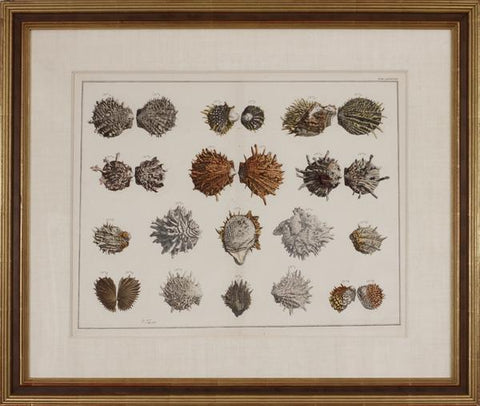Search By Artist
Albertus Seba (1665-1736)
Locupletissimi Rerum Naturalium Thesauri Accurata Descriptio et Iconibus Artificiosissimis Expressio, Per Universam Physices Historiam.
Amsterdam, Wetsten, Smith and Jannson-Waesberg, 1734-1765
Engravings with original hand-coloring.
One of the great eighteenth century "cabinet of curiosities" and one of the century's most desirable natural history books. Seba, a German-born apothecary and a wealthy member of the Dutch East India Company, practised in Amsterdam where his enormous wunderkammer became internationally famous as one of the city's essential sights. In 1717 his first collection was sold to Peter the Great of Russia. Most of the text of the first two volumes was written by Seba himself. After his death in 1736, publication could only be continued by using the proceeds of an auction of his second collection of curiosities. Seba's collaborators on the work included many noted scientists of the day, including H. Boerhaave, H.D. Graubius, P. Massuet and P. van Musschenbroek. Possibly the most important contribution was the description of fishes by P. Artedi who worked at the recommendation of Linnaeus (who declined an opportunity to participate himself).
The plates depict birds, mammals, insects, butterflies, reptiles, amphibians, spiders, millepedes, fish, molluscs, crustacea, minerals and fossils and sixty plates depicting some six thousand examples of shells in beautiful arrangements. The book is also popular for its illustrations of monsters and freaks of nature, including a seven-headed hydra and some almost unmentionable subjects which were probably the result of vivisection.


![Albertus Seba (1665-1736) Tab I [Insects]](http://aradergalleries.com/cdn/shop/products/I_large.jpg?v=1635434052)
![Albertus Seba (1665-1736) Tab II [Insects]](http://aradergalleries.com/cdn/shop/products/II_large.jpg?v=1635434726)
![Albertus Seba (1665-1736) Tab III [Insects]](http://aradergalleries.com/cdn/shop/products/III_large.jpg?v=1635434877)
![Albertus Seba (1665-1736) Tab L [Insects]](http://aradergalleries.com/cdn/shop/products/L_b_large.jpg?v=1635435506)
![Albertus Seba (1665-1736) Tab L [Insects]](http://aradergalleries.com/cdn/shop/products/L_large.jpg?v=1635437893)
![Albertus Seba (1665-1736) Tab LI [Insects]](http://aradergalleries.com/cdn/shop/products/LI_large.jpg?v=1635438265)
![Albertus Seba (1665-1736) Tab LII [Insects]](http://aradergalleries.com/cdn/shop/products/LII_large.jpg?v=1635434408)
![Albertus Seba (1665-1736) Tab LIII [Insects]](http://aradergalleries.com/cdn/shop/products/LIII_large.jpg?v=1635434214)
![Albertus Seba (1665-1736) Tab LXI [Insects]](http://aradergalleries.com/cdn/shop/products/LXI_large.jpg?v=1635435086)
![Albertus Seba (1665-1736) Tab LXII [Insects]](http://aradergalleries.com/cdn/shop/products/LXII_large.jpg?v=1635435223)
![Albertus Seba (1665-1736) Tab LXIII [Insects]](http://aradergalleries.com/cdn/shop/products/LXIII_large.jpg?v=1635436360)

![Albertus Seba (1665-1736) Tab LXXXII [Insects]](http://aradergalleries.com/cdn/shop/products/LXXXII_large.jpg?v=1635438414)
![Albertus Seba (1665-1736) Tab LXXXVII [Insects]](http://aradergalleries.com/cdn/shop/products/LXXXVII_large.jpg?v=1635438844)
![Albertus Seba (1665-1736) Tab LXXXVIII [Insects]](http://aradergalleries.com/cdn/shop/products/LXXXVIII_large.jpg?v=1635435683)
![Albertus Seba (1665-1736) Tab XCII [Insects]](http://aradergalleries.com/cdn/shop/products/XCII_large.jpg?v=1635435952)
![Albertus Seba (1665-1736) Tab XCIII [Insects]](http://aradergalleries.com/cdn/shop/products/XCIII_large.jpg?v=1635433429)
![Albertus Seba (1665-1736) Tab XCIX [Insects]](http://aradergalleries.com/cdn/shop/products/XCIX_large.jpg?v=1635438712)
![Albertus Seba (1665-1736) Tab XCV [Insects]](http://aradergalleries.com/cdn/shop/products/XCV_large.jpg?v=1635437502)